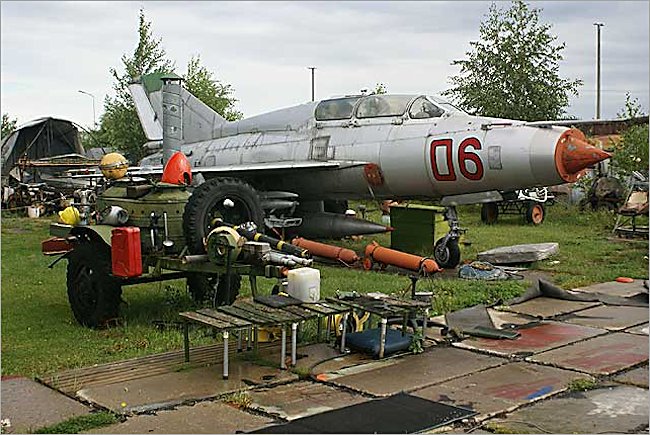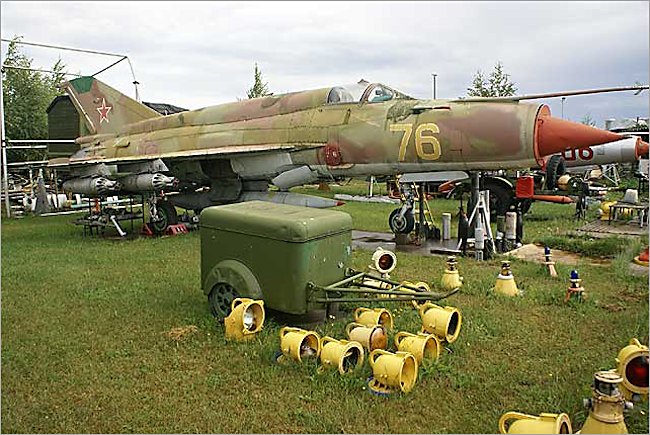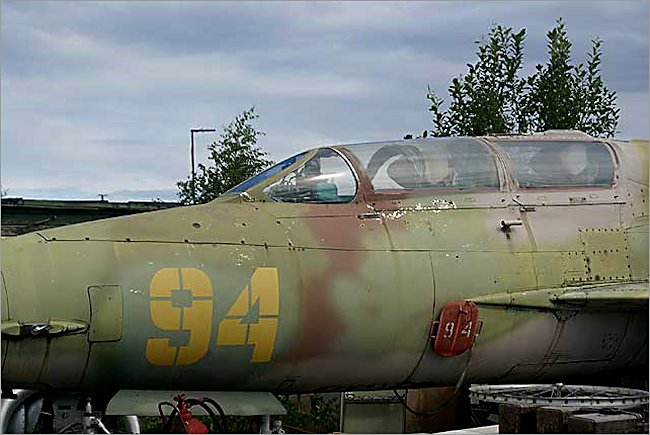MiG-21 Fishbed Jet Fighter
Some 50 countries over four continents have flown the MiG-21, and it still serves many nations a half-century after its maiden flight. It had the longest production run of a combat aircraft starting in 1959 and ending in 1985. There have been many different variants and upgrades over that time period. The primary users of the Mikoyan Mig-21Fishbed were the Soviet Air Force, Polish Air Force, Indian Air force and Romanian Air Force. Other Airforces also used Mig-21. They were Algeria, Angola, Bulgaria, Vietnam, East Germany, Egypt, Zambia, Cuba, Syria, Uganda, Czechoslovakia and Yugoslavia. The use of a tail with the delta wing aids stability and control at the extremes of the flight envelope, enhancing safety for lower-skilled pilots; this in turn enhanced its marketability in exports to developing countries with limited training programs and restricted pilot pools. It is believed that 11,496 Mig-21 jet fighters have been built.
The Mikoyan MiG-21 Fishbed ground attack jet fighter with the number 06 on the fuselage is a MiG-21US - Two-seat training fighter. This version is powered by a R-11F2S-300, thrust 3950 kgf (with afterburner 6175 kgf) engine. It had a crew of two and a maximum speed at 2,125 km/h (1,385 mph) Mach 2.05 with a range of 1,580 km (981 miles).

Photograph taken at the Russian Aircraft Museum next to Riga International Airport Latvia
The Mikoyan MiG-21 Fishbed was a lightweight fighter, achieving Mach 2 with a relatively low-powered afterburning turbojet, and is thus comparable to the American F-104 Starfighter and F-5 Freedom Fighter and the French Dassault Mirage III. It was the first successful Soviet aircraft combining fighter and interceptor characteristics in a single aircraft. Like many aircraft designed as interceptors, the MiG-21 had a short range. This was not helped by a design defect where the center of gravity shifted rearwards once two-thirds of the fuel had been used. This had the effect of making the plane uncontrollable, resulting in an endurance of only 45 minutes. The Mig21 MT and SMT variants were designed to deal with this issue and they had a range increase of 250 km (155 mi) compared to the MiG-21SM, but at the cost of a lower service ceiling and slower time to altitude.
Further development of famous Mikoyan MiG-21 Fishbed single-seat variant demanded upgrade of two-seat trainer - MiG-21U (Mongol-A). New modification was designated MiG-21US (Mongol-B) and performed its first flight in 1966. If to compare with earlier series MiG-21US received new, more powerful, engine R-11F2S-300, ejection seats KM-1M, increased fuel load (2030 kg (2450 liters)) and enlarged vertical fin, the same as for MiG-21PFM and later variants. During production on rear canopy was installed rising mirror to improve instructor's field of view on take-off or landing.
The Mikoyan MiG-21 Fishbed ground attack jet fighter with the number 76 on the fuselage is a Mig-21BIS single seat mulit role ground attack fighter. This version is powered by a Tumansky R-25-300 turbojet engine. It had a crew of two and a maximum speed at 2,125 km/h (1,385 mph) Mach 2.05 with a range of 1,580 km (981 miles). It had a service ceiling of 19,000 m (62,335 ft). Its armament was 2 air-to-air missiles R-3S (k-13T) AA-2B Atoll or 2 unguided rockets S-24 (240 mm caliber) or 2 unguide rocket pods (up to 64 rockets) or 2 bombs 250 kg each. It only had one crew member.

Photograph taken at the Russian Aircraft Museum next to Riga International Airport Latvia
This modification is famous by being involved in the sole Vietnam War official dogfight between Soviet and American pilots. This occurrence took place in 1972. The sole MiG-21US which was piloted by Vietnamese student-pilot and Soviet instructor and had not any armament, performed routine training flight over the North Vietnam. Whilst being 4 miles from the home base crew received warning that four "Phantoms" were approaching the airfield. At that moment Vietnamese fighter had only 800 litre of fuel. Trying not to be shot down crew performed sliding roll and defeated the first attack. Then MiG-21US was attacked twice but managed to disappoint all fired missiles successfully. The third attack also did not bring victory to American fighters but Mikoyan trying to avoid all missiles burnt all the fuel onboard, due to this problem pilots made the momentous decision and ejected safely.
The delta wing, while excellent for a fast-climbing interceptor, meant any form of turning combat led to a rapid loss of speed. However, the light loading of the aircraft could mean that a climb rate of 235 m/s (46,250 ft/min) was possible with a combat-loaded MiG-21bis,[1] not far short of the performance of the later F-16A. Given a skilled pilot and capable missiles, it could give a good account of itself against contemporary fighters. It was replaced by the newer variable-geometry MiG-23 and MiG-27 for ground support duties. However, not until the MiG-29 would the Soviet Union ultimately replace the MiG-21 as a maneuvering dogfighter to counter new American air superiority types.

Photograph taken at the Russian Aircraft Museum next to Riga International Airport Latvia
There has been a high death rate with pilots flying Mig-21 in the Indain Air Force. 100 pilots have been killed and it became known as the flying coffin. But despite this problem during the Indo-Pakistani War of 1971 the MiG-21s played a crucial role in giving the Indian Air Force IAF complete air superiority over vital points and areas in the western theater of the conflict. It was also used as late as 1999 in the Kargil War, in which one Indian Air Force MiG-21 was shot down by a Pakistani hand-held "Stinger" surface-to-air missile. In 1971 Indian pilots have been credited with successfully shooting down nine Pakistani Air Force aircraft types including Sabre F6, CC-130 and F-104A Lockheed Starfighter. Two IAF Mig-21s were shoot down by PAF US built F-86F Saber Jet Fighters.

Photograph taken at the Russian Aircraft Museum next to Riga International Airport Latvia
During the Vietnam War 13 of North Vietnam's flying aces attained that status while flying the MiG-21 jet fighters. MiG-21s were fast and had two ATOLL missiles which were very accurate and reliable when fired between 1,000 and 1,200 yard. Although the MiG-21 lacked the long-range radar, missiles, and heavy bombing payload of its contemporary multi-mission U.S. fighters, it proved a challenging adversary in the hands of experienced pilots and they shoot down a number of American Aircraft including F-4 Phantom, F-105 Thunderchiefs, RF-101 Voodoos, A-4 Skyhawk, F-8 Crusader, EB-66 Destroyer, Firebee, CH-53 Sea Stallion helicopter and B-52 Stratofortress

Photograph taken at the Russian Aircraft Museum next to Riga International Airport Latvia
The MiG-21 was also used extensively in the Middle East conflicts of the 1960s, 1970s and 1980s by the air forces of Egypt, Syria and Iraq against Israel. During the early stages of the 1991-1995 Yugoslav wars the Yugoslav People's Army used MiG-21s in a ground-attack role, while Croatian and Slovenian forces did not have air forces at the beginning of the war. Croatia acquired three MiG-21s in 1992 through defections by Croatian pilots serving with the JNA, two of which were lost in subsequent actions, one to Serbian air defenses, the other in a friendly fire accident. Croatian obtained a further 20 mig-21 and used them for ground attack missions.